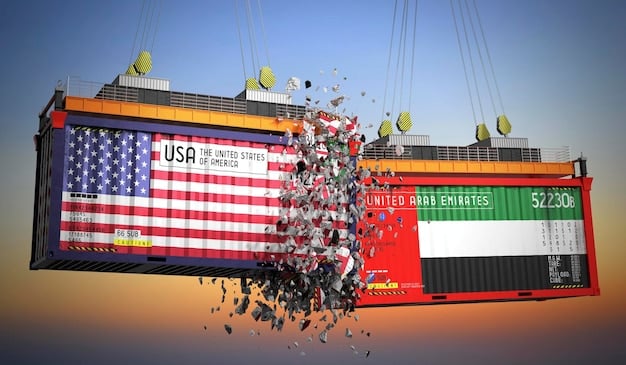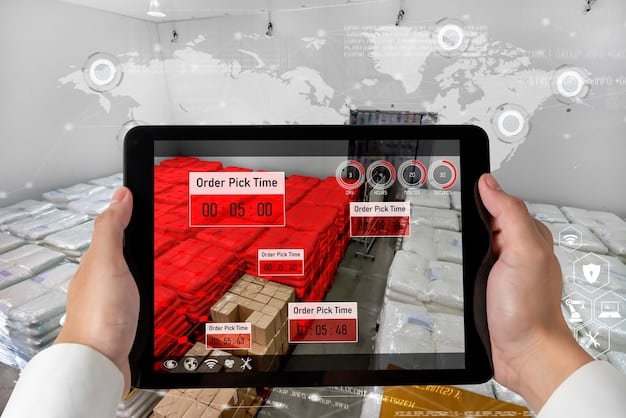U.S. Trade Deficit: Understanding Implications for Importers & Exporters

The U.S. trade deficit, representing the excess of imports over exports, significantly impacts American importers and exporters by affecting currency values, trade policies, and overall economic growth, thus requiring businesses to adapt strategies for global competitiveness.
Understanding the **US trade deficit** is crucial for businesses engaged in international trade. This article delves into the intricacies of the trade deficit, exploring its causes, consequences, and implications for importers and exporters in the United States.
What is the US Trade Deficit?
The US trade deficit occurs when a country’s imports exceed its exports. It’s a key indicator of a nation’s economic health and its engagement in the global marketplace. Analyzing this deficit offers valuable insights into the competitiveness of American industries.
The trade deficit isn’t inherently negative, but it can signify various economic challenges and opportunities. Understanding its composition and trends is crucial for informed business decisions. A consistently large deficit can raise concerns about domestic production and economic sustainability, particularly for businesses heavily reliant on exports.
Components of the Trade Deficit
Understanding the trade deficit requires breaking down its components. This reveals which sectors contribute most significantly to the imbalance and where potential growth opportunities lie.
- Goods vs. Services: The US often has a trade surplus in services but a deficit in goods, especially manufactured products.
- Geographic Distribution: The deficit varies significantly by country, with major trading partners like China, Mexico, and Canada having the most substantial impact.
- Commodity Breakdown: Identifying which specific goods (e.g., electronics, automobiles, oil) contribute most to the deficit.
By understanding these components, businesses can better assess their exposure to the effects of the trade deficit and identify opportunities for strategic adjustments.
In conclusion, the US trade deficit is a complex phenomenon with distinct components that necessitate careful analysis. For companies involved in international commerce, grasping these elements offers crucial perspectives for making well-informed choices, enhancing competitiveness, and strategically adjusting to market shifts.

Factors Contributing to the US Trade Deficit
Several factors contribute to the US trade deficit, including macroeconomic conditions, trade policies, and global competitiveness. Understanding these factors is essential for businesses to anticipate and adapt to changes in the trade landscape.
Exchange rates, comparative advantage, and consumer demand also play significant roles. Moreover, government policies, such as tariffs and trade agreements, can have a profound impact on the size and composition of the deficit. These factors must be continually monitored by companies seeking to navigate the complexities of international trade.
Exchange Rates and Currency Valuation
Exchange rates significantly influence the trade deficit. A strong dollar makes US exports more expensive and imports cheaper, widening the deficit.
Comparative Advantage and Specialization
Countries tend to specialize in producing goods and services where they have a comparative advantage. This can lead to trade imbalances if a country imports more goods than it exports due to cost-effective production elsewhere.
Comparative advantage plays a crucial role in shaping trade patterns. Different countries specialize in producing certain goods or services where their resources and capabilities offer an advantage. This specialization can lead to trade imbalances when a nation imports more specialized products than it exports, creating a trade deficit. Companies that understand comparative advantage are better positioned to optimize their supply chains and identify opportunities to enhance their global competitiveness.
In closing, the interplay of exchange rates and comparative advantage significantly influences the US trade deficit. Exchange rates affect import and export costs, while comparative advantage dictates how countries specialize in production. Businesses benefit greatly from understanding these factors to optimize their supply chains, identify opportunities to boost competitiveness, and navigate the complex dynamics of international trade.
Impact on US Importers
The US trade deficit presents both advantages and disadvantages for importers. While it can provide access to cheaper goods, it also exposes importers to currency risks and potential trade policy changes. Analyzing these dynamics is vital for successful importing strategies.
Fluctuations in exchange rates can impact the cost of imported goods. Changes in trade policies, such as tariffs, can also affect import prices and volumes. It is critical that importers stay informed about these issues to make prudent sourcing and pricing decisions.

Benefits of a Trade Deficit for Importers
A trade deficit can lower costs for importers, allowing them to source goods at competitive prices. This can translate into higher profit margins or the ability to offer lower prices to consumers.
With lower costs, importers can boost profit margins and provide consumers with cost-effective products. This is particularly beneficial for industries that rely on imported raw materials or components, enhancing their competitive edge. Moreover, importers gain access to a wider variety of goods, from consumer electronics to apparel, enriching the domestic market and meeting diverse consumer demands.
- Access to Cheaper Goods: Importers can source products from countries with lower production costs.
- Wider Variety of Products: A trade deficit can lead to a greater selection of goods available to US consumers.
- Increased Competition: Imports can drive competition, leading to innovation and lower prices.
In summary, a trade deficit can bestow significant advantages on importers. It allows for competitive sourcing, broadened product offerings, and heightened market rivalry. By effectively leveraging these benefits, importers can optimize their strategies, enhance profitability, and deliver more value to consumers.
Impact on US Exporters
For US exporters, the trade deficit can pose challenges. A strong dollar can make their goods more expensive in international markets, reducing their competitiveness. Therefore, businesses must find strategies to mitigate these disadvantages and maintain their export volumes.
Innovation, quality control, and effective marketing are critical for US exporters to remain competitive. In addition, exploring new markets and diversifying their customer base can help mitigate the impact of the trade deficit. It is important to note as well that engaging in trade promotion programs and seeking government support can also be beneficial.
Strategies for Exporters to Remain Competitive
Despite the challenges, exporters can employ various strategies to remain competitive, such as focusing on niche markets and offering specialized products.
By specializing and carving out distinct market positions, exporters can minimize direct competition and maintain profitability. This can involve investing in research and development to innovate and create proprietary products that command premium prices.
Below are Key strategies that help exporters thrive despite trade deficit challenges:
- Product Differentiation: Focus on unique, high-quality products that justify a premium price.
- Market Diversification: Explore new markets to reduce dependence on traditional export destinations.
- Currency Hedging: Mitigate the impact of currency fluctuations through hedging strategies.
In closing, US exporters can leverage strategies like market differentiation, strategic product development, and currency risk mitigation to overcome the challenges posed by the trade deficit. Embracing these approaches empowers exporters to sustain competitiveness, ensure profitability, and effectively traverse the complexities of the global market.
Government Policies and the Trade Deficit
Government policies, such as tariffs, trade agreements, and subsidies, can significantly impact the trade deficit. Businesses need to understand how these policies affect their operations and adjust their strategies accordingly.
Trade negotiations, in particular, can open new markets and reduce trade barriers. Government support for export promotion can also provide valuable assistance to US exporters. Staying informed about policy changes and engaging with government agencies is essential for businesses involved in international trade.
The Role of Tariffs and Trade Agreements
Tariffs can increase the cost of imported goods, potentially reducing the trade deficit. Trade agreements, on the other hand, can lower trade barriers and promote exports.
Tariffs increase the cost of imported goods, potentially diminishing the trade deficit by making foreign products more expensive. Meanwhile, trade agreements cut down trade barriers, leading to increased exports by offering preferential treatment and market access. Both policy instruments shape global trade and have direct implications for businesses.
Government intervention strategies that affect the trade deficit:
- Negotiating Trade Deals: Actively pursuing trade agreements that reduce barriers and promote fair trade practices.
- Enforcing Trade Laws: Ensuring compliance with trade regulations to prevent unfair trade practices like dumping.
- Supporting Export Initiatives: Providing resources and assistance to help US companies expand their export markets.
In final analysis, tariffs and trade agreements play essential roles in shaping the trade deficit. Tariffs can reduce imports, while trade agreements boost exports by lowering barriers and supporting equitable trade practices. Businesses should proactively monitor and engage with these policies to strategically adapt and prosper in the worldwide market.
Strategies for Businesses to Navigate the Trade Deficit
Navigating the trade deficit requires businesses to adopt proactive and adaptive strategies. This includes managing currency risks, diversifying markets, and focusing on innovation and quality. By implementing these strategies, companies can mitigate the negative impacts of the deficit and capitalize on new opportunities.
Effective supply chain management is also essential for reducing costs and improving competitiveness. In addition, businesses should invest in market research to identify emerging opportunities and stay ahead of industry trends. These comprehensive strategies allow businesses to thrive, regardless of the challenges posed by the trade deficit.
Diversification of Markets
Reducing dependence on any single market can mitigate the impact of the trade deficit. Exploring new markets and diversifying the customer base can provide stability and growth opportunities.
By entering new markets, businesses can lower risks associated with economic slowdowns or policy changes in any one location. Diversification also provides access to new customers and revenue streams, further stabilizing the business.
Below, diversification strategies for businesses as they navigate the trade deficit:
- Identifying New Markets: Researching and targeting countries with growing demand for US products.
- Adapting Products: Tailoring products and services to meet the specific needs of different markets.
- Building Local Partnerships: Collaborating with local businesses to gain market access and understanding.
In conclusion, diversifying into new markets enhances a company’s resilience and adaptability, as well as unlocking emerging opportunities for development. By targeting countries with rising product demand, modifying offerings to regional preferences, and establishing connections with local partners, firms can effectively traverse market complexities and accomplish sustainable expansion.
| Key Aspect | Brief Description |
|---|---|
| 📊 Trade Deficit | Occurs when imports exceed exports, affecting economic health. |
| 💰 Exchange Rates | Strong dollar makes exports expensive, imports cheaper. |
| 🛡️ Trade Policies | Tariffs and agreements impact trade balance and competitiveness. |
| 🌍 Diversification | Explore new markets to reduce dependence on any single market. |
Frequently Asked Questions
▼
The US trade deficit is influenced by factors such as strong consumer demand, the strength of the US dollar, and comparative advantages in production held by other countries.
▼
A large trade deficit can lead to job losses in export-oriented industries, while creating opportunities in sectors that rely on imported goods and materials.
▼
A trade surplus can boost domestic production, increase employment, and strengthen the national economy by increasing demand for domestically produced goods and services.
▼
Tariffs can reduce the trade deficit by making imports more expensive, but can also lead to retaliatory tariffs from other countries, harming export industries.
▼
Businesses can diversify their markets, hedge against currency fluctuations, and concentrate on product differentiation to mitigate the risks associated with the trade deficit.
Conclusion
In conclusion, understanding the complexities and implications of the **US trade deficit** is vital for importers and exporters. By implementing proactive strategies, businesses can overcome the challenges and capitalize on the opportunities presented by the global trade environment, ensuring long-term success and sustainability.





